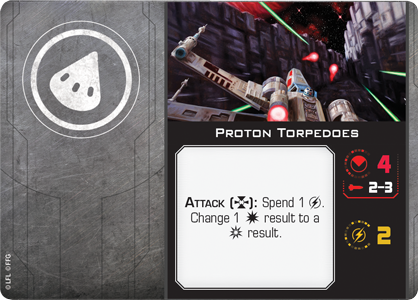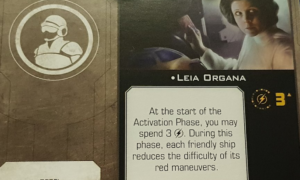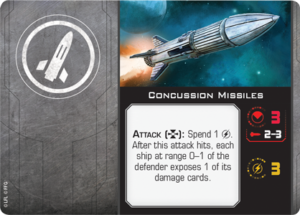
Design space. This is a term we’ve mentioned a few times in our reviews of the coming second edition of X-Wing. But what does it really mean? Well, to put it simply, design space is the options the game developers have available to them when working on the game. For example, four-speed turn maneuvers are an example of something that is outside the game’s design space. The templates do not exist. Resetting the game with a new version gave the devs a chance to expand the available design space. We’ll hit a couple of big ones today and explore what they mean for the future of the game.
Charges
When X-Wing 1.0 launched, cards existed in a binary state. Either you had them or you didn’t. If a card had a limited use that limit was always one. The only delineator was flipping a card over. This meant any card effect could be used once or infinite amounts. If the devs wanted a card to be used two or three times they were out of luck.
This limitation meant cards either had to have their power carefully balanced for use in the entire game, or they had to be really valuable to justify the one and done usage. Lightning Reflexes and Crack Shot cost the same and had the same number of uses. But Crack Shot was more powerful and something you probably don’t want players doing multiple times in a game. LR was a fun ability but was rarely taken compared to Crack Shot. Should CS cost more? Maybe, but would that make it cost too much for a one-time ability?
The developers tried to get around the limitation issue in a few ways. First, Extra Munitions was added for ordnance. This allowed ships to get multiple uses out of their expensive weapons. Once this came into the game, it had an immediate impact. People started using ordnance again because instead of four points for a one time use, you spent six points for two uses. This made them more cost-effective and worth slotting.
 Unfortunately, because of the design of the game, Extra Munitions had to be added as an existing type of upgrade. Otherwise, older ships wouldn’t be able to make use of it. So it became a Torpedo slot, since many ships had multiple of those. A reasonable solution, given the limitations, but it still left anything with only one torpedo slot out in the cold. Another attempt at limiting usages came about in the form of dual cards like Intensity. There were no limits to how many times you could use it but the card came with a cost of spending a focus token. Later, Reload was added as an action but it was only available to new ships, leaving ships that should reasonably have it, like the TIE Punisher, to do without.
Unfortunately, because of the design of the game, Extra Munitions had to be added as an existing type of upgrade. Otherwise, older ships wouldn’t be able to make use of it. So it became a Torpedo slot, since many ships had multiple of those. A reasonable solution, given the limitations, but it still left anything with only one torpedo slot out in the cold. Another attempt at limiting usages came about in the form of dual cards like Intensity. There were no limits to how many times you could use it but the card came with a cost of spending a focus token. Later, Reload was added as an action but it was only available to new ships, leaving ships that should reasonably have it, like the TIE Punisher, to do without.
But with 2.0 all of this is fixed and much more with the concept of Charges. Now, any ability that needs a limit comes with Charges. The devs can tailor how many charges it has, how many charges it takes to use, and if those charges regenerate. With this spread you can do things like Leia, give her a powerful ability that can be used every three rounds. 1.0 Leia sucked because she cost so much and could only be used once. 2.0 Leia can be used infinite amounts but only every three rounds. This requires more planning on the player’s part which makes for a more interesting game.
Charges can also be used as just a record keeping system. If a pilot or upgrade is supposed to have a once per round ability, they get a charge with a recharge. Each round they can use it, spend the charge and then get it back for next round. In 1.0 you had to remember if you had used an ability. While not common or complicated, it could lead to confusion and disagreement.
Secondary Weapons
 Going along with the addition of Charges, the entire concept of secondary weapons has been redesigned. Before, every weapon followed the same rules. No range bonuses were applied. They could only be fired out of the front arc. Unless it was a turret and then each one had a long piece of clarifying text explaining you could fire out of arc.
Going along with the addition of Charges, the entire concept of secondary weapons has been redesigned. Before, every weapon followed the same rules. No range bonuses were applied. They could only be fired out of the front arc. Unless it was a turret and then each one had a long piece of clarifying text explaining you could fire out of arc.
Now, with the redesign, each weapon can be designed a number of different ways. The default position is now that secondary weapons get range bonuses. But those with a missile icon next to the range, see the Concussion Missile card, do not get the range bonus. That means missiles/torpedoes can continue to benefit at range 3 and cannons can now work more like primary weapons.
Additionally, with the arc display on the card, weapons have that information presented more succinctly. Turrets no longer need a blurb of text, one image does the trick. While most weapons will have a forward arc displayed there could be a rear arc cannon added. Or a side cannon should the devs desire.
System Phase
Another major change is the creation of the System Phase. Coming after Planning but before Activation, the System phase shores up a major weakness that developed in 1.0 the older it has gotten. As more things were added to the game, more and more things started to have either overlapping timing or their own unique timing. “Before” and “after” as timing windows always bring about a lot of questions. One such, what is the difference between “after Planning” and “before Activation”? Maybe nothing, maybe everything.
To resolve that, and many other things, the System phase has been introduced. Now there is an entire phase where anything that needs to happen after dials are set but before anyone moves can trigger. Decloak happens during this phase as well as non-emergency undocking. The main thing, for most games, that now happens during the System Phase is dropping/launching bombs. This change will make a major difference in what type of ships get used as bombers. Before, if you wanted to drop mines, you took low PS so they could drop before other ships move. If you wanted bombs, you took high PS so everyone would have already moved. But now, all the pilots are the same so any ship with a bomb slot can get use out of it.
Ship Abilities
The final design space addition we’ll discuss is the inclusion of non-pilot abilities onto ships. Previously, to give a ship some special ability it would be required to take an upgrade. Take Adaptive Ailerons as an example. The TIE Striker was designed with them in mind. That’s why the ship has a max speed of three. But since the card is an upgrade, it wasn’t required and could be flown without it. This made the ship hard to balance.
With the addition of ship abilities, upgrades like this are now baked right into a ship. This gives the devs a tremendous amount of design space for new ships moving forward. The TIE Bomber, as another example, now comes with “Nimble Bomber” allowing them to drop bombs with the one bank. This helps distinguish them from any other ship that can drop bombs. They are, after all, a bomber, so should be the best at dropping bombs. In 1.0 there was no easy way to do this.
We will be covering the changes to ships, including all the new ship abilities in the coming weeks so we’ll get into those in more detail later.
Was 2.0 necessary for these changes?
Yes. To gain design space, the game had to be rebooted. You could not add Charges to upgrades and abilities without either making the new ones with them more valuable or rereleasing every upgrade, which a 2.0 does. You can’t mess with the fundamental game structure, such as adding a System Phase, without a 2.0 because it would mess with so many different things.
This aspect of 2.0 is what I look forward to the most. All of the new design space means more interesting and hopefully, balanced, changes coming to the game.
